.

Prime Minister Shinzo Abe announced Tuesday that Japan will remain part of the U.S.-led International Space Station project when it is extended until 2024, strengthening its alliance with the United States as China advances into space.
The four-year extension was proposed by the United States. Of the 15 countries participating in the ISS, Russia and Canada have already expressed their intent to remain in the project, while European members have yet to decide.
“We will faithfully implement the schedule for our basic space program and work on an aggressive space strategy,” Abe said at a ministerial meeting on space development.
As the sole Asian member of the ISS project, Japan plans to stick with the extended project on the condition that other Asian countries are given a chance to use the Japanese laboratory unit Kibo, which is currently shared with the United States.
The government apparently believes opening Kibo for other countries would help Japan and the United States increase their presence in Asia at a time when China is rising as a new major power in space exploration.
The U.S. proposed in January 2014 extending the ISS project beyond 2020 in hopes of using the facility as a foothold for an eventual manned mission to Mars.
Project participants need to make contributions matching their investment ratio in return for having their own astronauts live on the ISS, To meet this requirement, Japan plans to ship supplies to the space station with its improved Konotori unmanned cargo transporter, according to government officials.
The Japan Aerospace Exploration Agency is also considering providing a next-generation life-support system to the ISS, the officials said.
So far, Japan has invested ¥900 billion ($7.3 billion) toward the ISS project, putting aside ¥35 billion to ¥40 billion a year.
The ISS, constructed between 1998 and 2011 in an orbit some 400 km above Earth, is a massive facility comprising laboratories, living quarters, solar panels and other sections.
Quelle: The Japan Times
3889 Views
